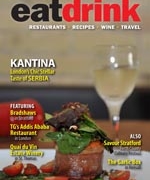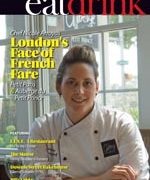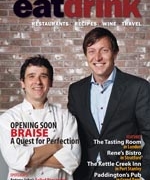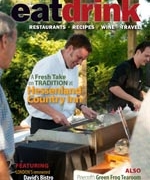Rustle Up Some Grubs
When it comes to using insects as food, a cry of “Bring on the delicacies” comes from certain cultures, whereas others need to be near-to-death starving before considering bugs for dinner. Two recent books, Edible: An Adventure into the World of Eating Insects and the Last Great Hope to Save the Planet by Daniella Martin and Eat the Beetles! An Exploration into our Conflicted Relationship with Insects by David Waltner-Toews, have taken steps beyond these polarizing camps by arguing that entomophagy (the eating of insects) has a lot going for it: a plentiful wild supply, far less resources required to farm them, no butchering involved, and high nutritional value.
Martin got interested in entomophagy as an anthropology student in Mexico. She extended her globetrotting to get experiences with cultures more accepting of such a practice. In Edible, she promotes her theory that “insects are the great untapped resource, the final frontier of natural food” by going to underground, bug-eating parties in Tokyo and Noma (touted as the world’s best restaurant) in Copenhagen that incorporates bugs into its haute cuisine menu. Her philosophy of “farm pest to table” utilizes the natural world to counteract some harmful impacts of traditional farming; one theory is that fields attract insects and can simultaneously be harvested while picking the crops. A yield of two different food sources can be extracted from the same plot of land, instead of disposing of one with pesticides and harming the other at the same time. These are the types of compelling ecological, economical, and practical reasons Martin has for eating insects, but she also knows how tasty they can be.
The first bugs she tried were toasted grasshoppers in Mexico. While not overly enjoyable, she saw the appeal with their resemblance to burnt potato chips. Many bugs are compared to peanuts, almonds, and pistachios, with an overall consensus of having a nutty flavour profile. Martin likens queen ants to beef jerky popcorn kernels and fried bamboo worms to extra crispy French fries. The first time Martin experimented at home, after mail-ordering wax moth larvae, she says they smelled liked mushrooms while cooking and tasted like earthy, savoury raisins.
Early in her research, Martin confesses to being “on high alert for digestive disturbances” especially since insects are nearly always eaten whole, including the outer shells not easily digested by humans. Even with the smorgasbord of insects she has sampled, including the tougher-to-swallow critters like scorpions and whole tarantulas (the former she compares to crab and the latter to chewy Korean barbeque), she admits that insects have never caused any gastrointestinal problems. But she knows there is a stigma to overcome, so Martin digs deep with nutritional and ecological arguments to make her case for insect eating, also including an appendix of insects that are safe to consume and a compendium of some tried-and-true recipes (Wax Moth Tacos or Cricket Kale Salad, anyone?). It may not be easy for North Americans to whole-heartedly swallow the idea, but even insinuating insects into one’s diet in small doses could lead to major change.
Coming out three years after Martin’s book, Waltner-Toews, a veterinarian from Kitchener, has expanded on this topic in Eat the Beetles! and I was curious to see if entomophagy has become more acceptable: Have insects been popping up on more restaurant menus? Have they graduated from exotic to mainstream? Have insect farms started replacing cattle farms? Has a reliance on insects as food helped the world or has the trend stayed too small to have an impact? Are the squeamish still too squeamish?
While the writing style of Martin had more of a pop culture vibe, that of Waltner-Toews is more scientific, albeit very readable and enjoyable, especially with his whimsical reference to the (human) Beatles, not only in the title, but in chapters alluding to Fab Four songs – Cricket to Ride; Can’t Buy Me Bugs; I Am the Cockroach. Each punny chapter deals with questions that have cropped up since “global beetle-mania.” His research takes him to fine dining in Paris for the best insect preparations, wasp hunting in Japan, and cricket farming in Cambodia. One thing that the three years between these books has provided is more time for scientific research, to see if entomophagy has teeth to support global food security or will lead to newer ecological disasters. There is a deep symbiotic relationship between insects and the natural world and taking away too many insects from the wild could have unintentional consequences. This concern leads Waltner-Toews to the viable options currently underway in insect farming.
Although optimistic about bugs showing up in markets and on menus, Waltner-Toews’ tone is more cautious compared to Martin’s enthusiasm to convert all of us to insect eaters. He has good experiences sampling bug dishes: palm weevil larvae taste like dried figs to him and seasoned crickets are a legitimate substitute for greasy bar snacks. Given the overarching comparisons to snack foods, bugs may not have leapt to the plate to replace meat entrees yet; their main success comes as protein replacements in tacos surrounded by the other accoutrements to make a Mexican-style meal. For the newly initiated, some of the least offensive offerings are insect eggs as seasoning on upscale dishes (similar to the use of caviar) or an amalgam of bugs mixed with vegetables in stir-fries or salads. Some companies are successful using ground-up cricket flour as protein powder in energy bars to mask any resemblance to six-legged creatures.
For many cultures, epidemiology and gastronomy have already collided in ancient methods of sustenance or as more recent trends to embellish menus. Leaving taboos at the door while reading these books may lead to some new tasty snacks, while jumping into a movement that can alleviate global problems. Even if overcoming cultural aversions seems difficult, remember that bugs are already engrained in many indigenous cuisines and the advice of Waltner-Toews is: “If you are a guest in another country, and they offer you bugs to eat, it is rude to decline the offer.”










